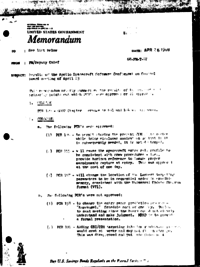Upthread: Results of the Apollo Spacecraft Software Configuration Control Board meeting of April 9 (Apr 16, 1968)
Downthread: Results of the June 11 Apollo Software Configuration Control Board (ASCCB) meeting (Jun 12, 1968)
See list belowAPR 26 196868-FM-T-87PA/Chief, Apollo Data Priority CoordinationResults of the Apollo Spacecraft Software Configuration Control Board meeting of April 23
This memorandum briefly summarizes the results of the meeting and primarily points out which PCR's were approved or disapproved.
1. SUNDISK
PCR 1�� – GSOP Chapter � ������ to R�1 and R�4 was approved.
2. COLOSSUS
a. The following PCR's were approved:
(1) PCR 1�� – to permit storing the present CSM state vector while doing cis-lunar navigation so that if it is subsequently needed, it is not destroyed.
(2) PCR 155 – will cause the spacecraft entry roll profile to be consistent with crew procedures – i.e., provide horizon reference to insure proper aerodynamic capture at entry. This was approved at the cost of one day.
(3) PCR 157 – will change the location of the Lambert targeting parameters to be in sequential order in erasible memory, consistent with the Universal Update Program format (V71)
b. The following PCR's were not approved.
(1) PCR 158 – to change the entry range predictor program “Augekugel.” Schedule cost of one day. Delayed to next meeting since the board could not clearly understand and make judgment. MPAD is to provide a formal presentation.
(2) PCR 101 – Adding CSI/CDH targeting into the rendezvous program would cost six weeks and may not fit in storage. This was disapproved and put into Colossus 2 hopper to be reviewed at the enxt joint program development plan meeting at MIT in a couple of weeks.
(3) PCR 132 – to provide a DSKY light to indicate VHF data good. This was tabled until George Low's CCB presentation the hardware.
3. COLOSSUS #2 (for mission “D” and/or “E”)
The following PCR's were approved (I think):
a. PCR 134 – pulse torquing of the IMU to permit spacecraft naviga- tion flexibility while avoiding gimbal lock.
b. PCR 156 – will provide an automatic “proceed” to ����� ��� display format when under peak reentry “g” ������.
4. LUMINARY
PCR 1�9 – to get rendezvous radar data on the downlink while on the lunar surface. MIT evaluation is incomplete although apparently the impact is approximately two days. Delayed until detailed information is availabled.
5. PCN's by MIT (eight of them) are tentatively approved but will be formally reviewed at the next meeting. Most are GSOP and/or coding changes MIT feels are necessary to make the program work and meet speci- fications. There are several that MPAD people should investigate before then. Stan Mann is personally contacting those concerned to get their comments. If there is no objection, they will be approved.
- Apr 16, 1968 – Results of the Apollo Spacecraft Software Configuration Control Board meeting of April 9 (7.1σ)
- Mar 07, 1968 – Apollo Spacecraft Software Configuration Control Board notes for March 4 meeting (4.1σ)
- Oct 16, 1968 – Results of the October 8 Apollo Spacecraft Software Configuration Control Board (ASSCCB) meeting (3.6σ)
- Sep 23, 1968 – Results of September 17 Apollo Spacecraft Software Configuration Control Board (ASSCCB) meeting (3.4σ)
- May 29, 1968 – Spacecraft computer program – things dealing with lunar descent and aborts from it (3.2σ)


